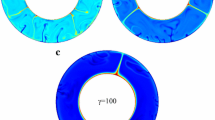Abstract
Assuming a radially stratified Newtonian mantle in a steady-state approximation, we demonstrate that the permeability of a viscosity interface at 660-km depth strongly depends on the wavelength of buoyancy forces driving the flow. The flow induced by long-wavelength loads penetrates through the boundary freely even if the viscosity increases by two orders. In contrast, the boundary is practically impermeable for short-wavelength loads located in the upper mantle. Thus, a stepwise increase of viscosity is a significant obstacle for small descending features in the upper mantle, but huge upper mantle downwellings, or upwellings formed in the-lower mantle can overcome it easily. This indicates that certain care is necessary in interpreting the seismic structure of the mantle by means of flow models. The global tomographic image includes only the first few degrees of the harmonic series and, consequently, its interpretation in terms of a present-day flow field results in a predominantly whole-mantle circulation even for extreme viscosity contrasts.
Similar content being viewed by others
References
Bina C.R., 1991: Mantle discontinuities. Rev. Geophys., supplement, 783–793.
DeMets C., Gordon R.G., Argus D.F. and Stein S., 1990: Current plate motions. Geophys. J Int., 101, 425–478.
Gurnis M. and Hager B.H., 1988: Controls of the structure of subducted slabs. Nature, 335, 317–321.
Hager B.H., 1984: Subducted slabs and the geoid: Constraints on mantle rheology and flow. J. Geophys. Res., 89, 6003–6016.
Hager B.H. and Clayton R.W., 1989: Constraints on the structure of mantle convection using seismic observations, flow models and the geoid. In: W. R. Peltier (Ed.), Mantle Convection, Plate Tectonics and Global Dynamics, Gordon and Breach Scientific Publishers, pp. 657–763.
Karato S. and Wu P., 1993: Rheology of the upper mantle: A synthesis. Science, 260, 771–778.
Karato S., Zhang S. and Wenk H.R., 1995: Superplasticity in Earth's lower mantle: Evidence from seismic anisotropy and rock physics. Science, 270, 458–461.
King S.D., 1995: Radial models of mantle viscosity: Results from a genetic algorithm. Geophys. J. Int., 122, 725–734.
Lambeck K., Johnston P., Smither C. and Nakada M., 1996: Glacial rebound of the British Isles — III. Constraints on mantle viscosity. Geophys. J. Int., in press.
Mitrovica J.X., Davis J.L. and Johansson J.M., 1995: The radial profile of mantle viscosity: Searching for a consensus (abstract). IUGG General Assembly, Boulder, p. B395.
Morgan J.P. and Shearer P.M., 1993: Seismic constraints on mantle flow and topography of the 660-km discontinuity: evidence for whole mantle convection. Nature, 365, 506–511.
Peltier W.R., Drummond R.A. and Tushingham A.M., 1986: Postglacial rebound and transient lower-mantle rheology. Geophys. J. Royal. Astr. Soc., 87, 79–116.
Ranalli G., 1991: The microphysical approach to mantle rheology. In: R. Sabadini, K. Lambeck and E. Boschi (Eds.), Glacial isostasy, sea-level and mantle rheology, Kluwer, Dordrecht.
Ricard Y., Richards M.A., Lithgow-Bertelloni C. and LeStunff Y., 1993: A geodynamic model of mantle density heterogeneity. J. Geophys. Res., 98, 21895–21909.
Ricard Y., Sabadini R. and Spada G., 1992: Isostatic deformations and polar wander induced by redistribution of mass within the Earth. J. Geophys. Res., 97, 14223–14236.
Richards M.A., 1991: Hotspots and the case for a high viscosity lower mantle. In: R. Sabadini, K. Lambeck and E. Boschi (Eds.). Glacial isostasy, sea-level and mantle rheology, Kluwer, Dordrecht.
Su W.J. and Dziewonski A.M., 1991: Predominance of long-wavelength heterogeneity in the mantle. Nature, 352, 121–126.
Thoraval C., Machetel Ph. and Cazenave A., 1995: Locally layered convection inferred from dynamic models of the Earth's mantle. Nature, 375, 777–780.
Tushingham A.M. and Peltier W.R., 1992: Validation of the ICE-3G model of Wurm-Wisconsin deglaciation using a global data base of relative sea level histories. J. Geophys. Res., 97, 3285–3304.
van den Berg A.P. and Yuen D.A., 1996: Is the lower-mantle rheology Newtonian today? Geophys. Res. Lett., 23, 2033–2036.
Weertman J., 1978: Creep laws for the mantle of the Earth. Phil. Trans. R. Soc. London, A288, 9–26.
Author information
Authors and Affiliations
Rights and permissions
About this article
Cite this article
Čížková, H., Čadek, O. & van den berg, A.P. Influence of the Load Wavelength on the Permeability of a Viscosity Interface in the Mantle. Studia Geophysica et Geodaetica 41, 64–72 (1997). https://doi.org/10.1023/A:1023388707657
Published:
Issue Date:
DOI: https://doi.org/10.1023/A:1023388707657




